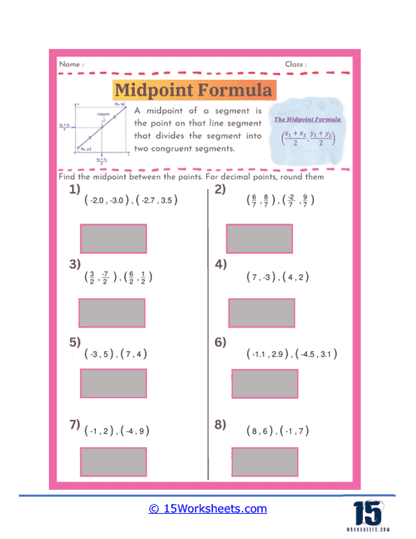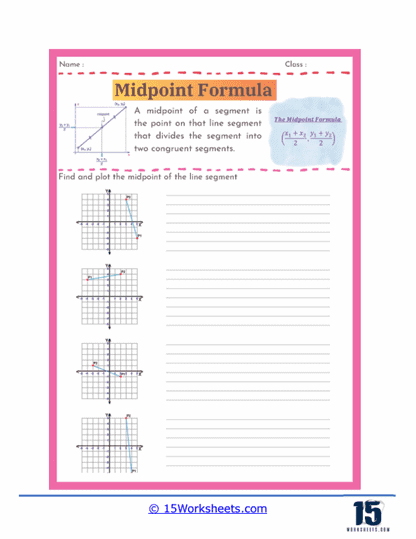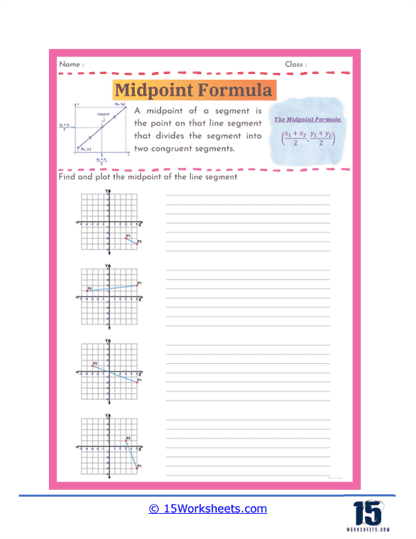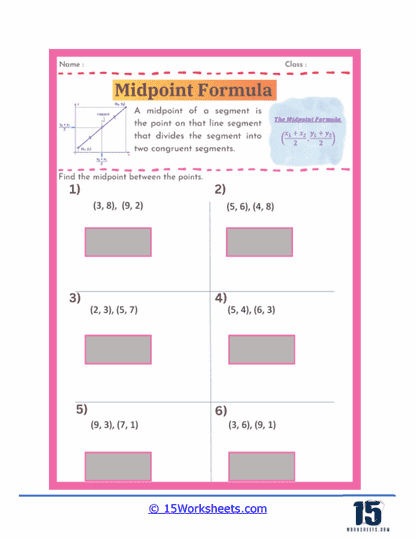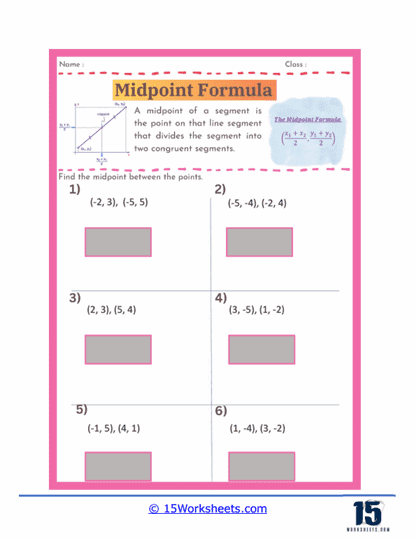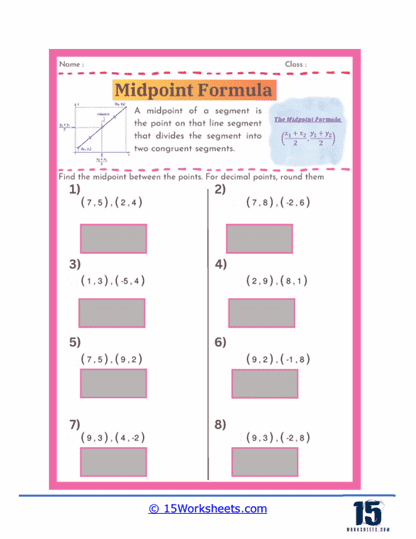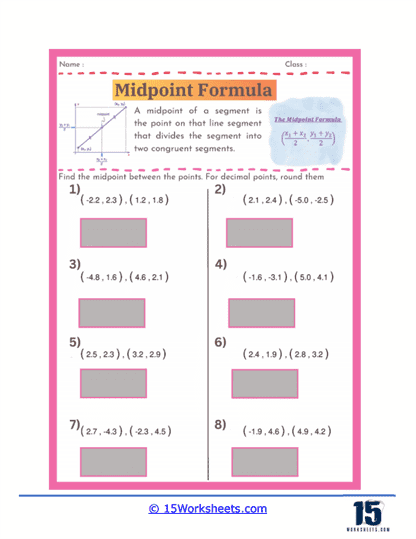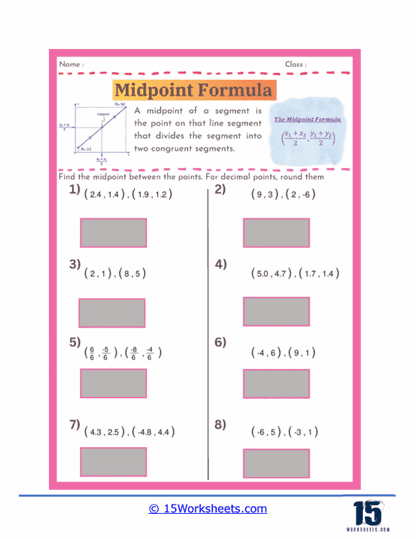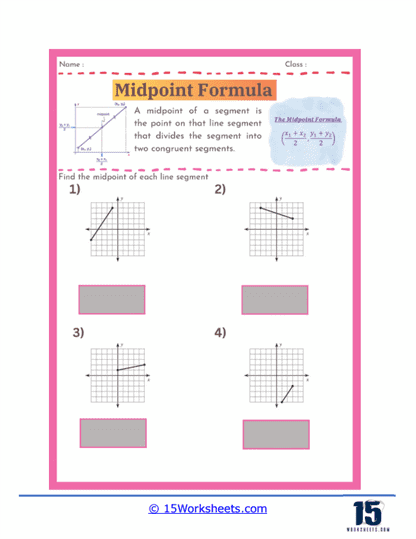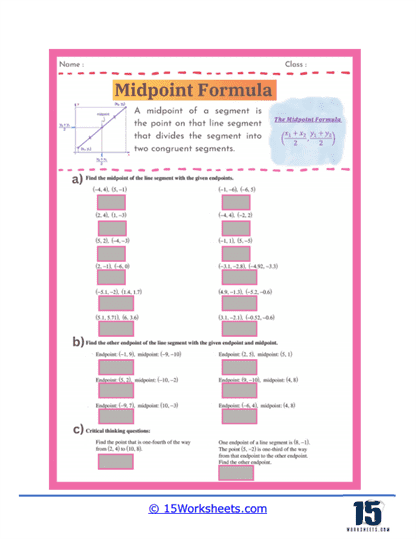Midpoint Formula Worksheets
About These 15 Worksheets
These worksheets were designed to help students practice and master the concept of finding the midpoint of a line segment using its endpoints. These worksheets typically feature a variety of problems that require students to calculate the midpoint by applying the midpoint formula. The formula itself is a straightforward application of averaging the coordinates of the endpoints to find the exact center point of a line segment. By engaging with these worksheets, students develop a strong foundation in coordinate geometry and enhance their mathematical reasoning skills.
The Math Skills Explored
Midpoint Formula worksheets focus on several key math skills that are crucial for a deeper understanding of geometry and algebra. First and foremost, they help students become proficient in using the midpoint formula, which is essential for many geometric constructions and proofs. Additionally, these worksheets enhance students’ abilities to work with coordinate pairs, improving their precision in calculations and their understanding of the Cartesian plane.
Students also develop their problem-solving skills as they apply the midpoint formula to various types of problems. They learn to interpret and manipulate coordinates, which is a vital skill for more advanced studies in mathematics. Furthermore, these worksheets encourage students to think critically about geometric relationships and spatial reasoning, both of which are important for fields that require analytical thinking.
Types of Exercises
Midpoint Formula worksheets include a diverse range of exercises designed to reinforce the concept and application of the midpoint formula. Some common types of exercises found in these worksheets are:
Basic Midpoint Calculation – These exercises are the foundation of midpoint formula worksheets. Students are given the coordinates of the endpoints of a line segment and are asked to calculate the midpoint. For example, a problem might provide the endpoints (1, 2) and (3, 4) and ask the student to find the midpoint. These problems help students practice the straightforward application of the midpoint formula.
Plotting Midpoints on a Graph – In these exercises, students are required to plot the endpoints of a line segment on a coordinate plane and then determine and plot the midpoint. This type of exercise helps students visualize the concept of a midpoint and understand how it divides the line segment into two equal parts. It also reinforces their skills in graphing and working with the Cartesian plane.
Word Problems – Word problems add a layer of complexity by presenting real-world scenarios where students must find the midpoint. For example, a problem might describe two locations on a map with given coordinates and ask the student to find the midpoint, which could represent a meeting point. These problems help students see the practical applications of the midpoint formula and enhance their problem-solving skills.
Finding the Missing Endpoint – Some exercises challenge students to find the missing endpoint of a line segment when given one endpoint and the midpoint. This type of problem requires students to manipulate the midpoint formula and solve for the unknown coordinate. It helps deepen their understanding of the formula and develop their algebraic manipulation skills.
Critical Thinking Questions – Midpoint Formula worksheets often include questions that require students to apply their knowledge in new and challenging ways. For example, a problem might ask students to explain why the midpoint formula works or to derive the formula from basic principles. These questions encourage students to think critically about the concepts they are learning and to deepen their understanding of geometry.
Benefits of These Worksheets
Midpoint Formula worksheets offer numerous benefits for students. They provide structured practice that helps students master the concept of midpoints and build a strong foundation in coordinate geometry. By working through a variety of problems, students enhance their computational accuracy and develop their ability to handle coordinates and geometric relationships with confidence.
These worksheets also foster critical thinking and problem-solving skills. As students tackle different types of problems, they learn to apply the midpoint formula in various contexts and to think creatively about geometric concepts. This prepares them for more advanced studies in mathematics and related fields, where analytical thinking and precision are essential.
These worksheets make learning engaging and interactive. By incorporating graphing exercises, word problems, and critical thinking questions, these worksheets provide a well-rounded approach to learning that keeps students interested and motivated. They also help students see the real-world relevance of the concepts they are studying, which enhances their appreciation for mathematics.
Real-World Example
Consider the field of urban planning. Urban planners often need to find central points between various locations to place public facilities such as parks, community centers, or transportation hubs. By using the concept of midpoints, they can determine the most convenient and accessible locations for the majority of residents. For instance, if a planner is deciding where to build a new park, they might use the coordinates of several neighborhoods and calculate the midpoint to find a central location. This ensures that the park is equally accessible to everyone, promoting a more equitable and efficient use of space. The skills developed through Midpoint Formula worksheets directly apply to such real-world scenarios, highlighting the practical importance of understanding and mastering these concepts.
Example problem: Find the midpoint of the line segment with endpoints at (2, 5) and (8, 11).
Solution
Step 1: Identify the coordinates of the endpoints.
a. The first endpoint is (2, 5).
b. The second endpoint is (8, 11).
Step 2: Add the x-coordinates of the endpoints.
2 + 8 = 10
Step 3: Add the y-coordinates of the endpoints.
5 + 11 = 16
Step 4: Divide the sum of the x-coordinates by 2 to find the x-coordinate of the midpoint.
10 / 2 = 5
Step 5: Divide the sum of the y-coordinates by 2 to find the y-coordinate of the midpoint.
16/2 = 8
Step 6: Combine the results from Steps 4 and 5 to find the midpoint.
The midpoint is (5, 8).
Final Answer: The midpoint of the line segment with endpoints at (2, 5) and (8, 11) is (5, 8).






